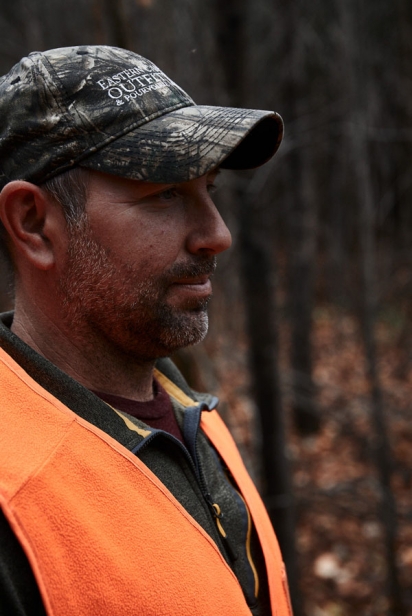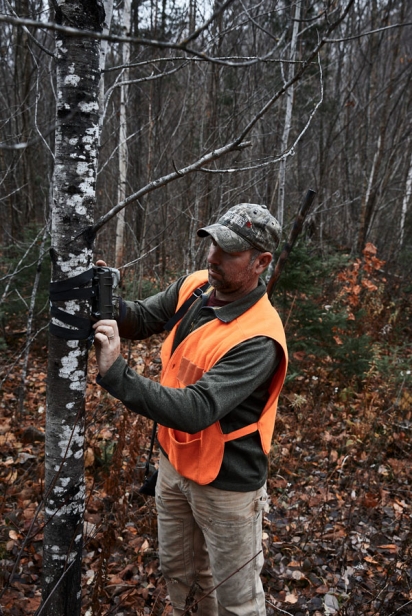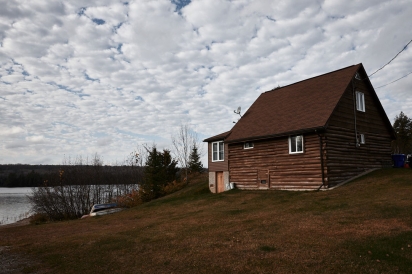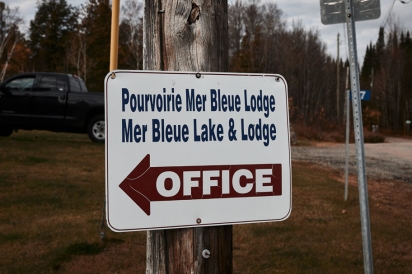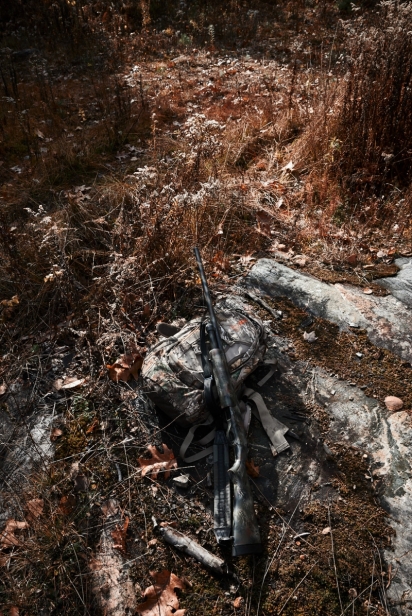Hunting for Grouse
It’s a late fall day when Rob Argue, the owner of Eastern Canadian Outfitters, leads us into 275 acres of woodland about an hour and a half to the north of Ottawa, just outside the little village of Cayamant, Que. A few yellow leaves remain, fluttering on the trees as a warm breeze rustles the long-spent wild raspberry canes. We ditch the truck and get out to walk the cleared paths of this extensive patch of crown land, completely alone for miles around.
Argue has a lean, camouflage-painted 12-gauge shotgun hugged tightly to his body as he walks along the paths, eyes casting ahead, one ear to the sounds coming from the brush and the other to our quiet conversation. We’re on the hunt for grouse. Suddenly, there’s a noise to our right and two birds scuttle through the undergrowth, while a third, perched in a tree, takes off with that telltale wobbly flight pattern, first the left wingtip dipping, then the right as he makes his escape. Argue fires no shots.
It’s a grey, still day and not ideal for grouse hunting late in the season. Argue explains that the birds usually come out to forage on the ground when the sun’s out, feeding along the edge of the dense brush. But on this day, they’re clearly having a pajama party and staying in bed. Nonetheless, we walk down the winding paths, past hunting blinds and stands several feet up in the trees, through clearings sown with clover and feeders to entice bear and deer out of the woods and into the line of fire. Suddenly, Argue is alert from head to toe and gestures towards something I can’t see farther down the path. Off he goes, treading lightly, gun to shoulder. Whatever it is has made its way off the track and soon enough he’s deep in the birch woods, visible only due to his orange hunting vest, a legal requirement when shooting with a shotgun or rifle.
Hunting is big business across Canada. An October 2019 report from the Conference Board of Canada, found there are 1.3 million hunters across the country. Their hunting contributed $4.1 billion in GDP and supported 33,000 jobs. And that’s to say nothing of fishing.
Argue owns two lodges in Quebec and leases land in Ontario; the first lodge is a stone’s throw from Ottawa, if you are measuring in distances proportionate to the Canadian wilderness. Just two hours drive from the city, four small cottages perch on the bank of Lac Cayamant, and Argue leases 27 square kilometres of land nearby for hunting, as well as fishing rights on the lake. The second is in northern Quebec, where he leases 216 square kilometres of land and takes mostly American hunters who are after big game — bear and moose. In Ontario, he leases approximately 2,000 acres in the countryside near Perth.
“Americans love to come up here to hunt,” Argue explains, “because they simply can’t believe the wilderness. Sometimes, where they come from, they’ll be standing just a few feet away from another hunter, while here it’s unusual to see another soul.” This, Argue says, really allows them to have an authentic experience, to spend large chunks of time in nature and if they’re lucky, they’ll bag a deer or some grouse, too.
But for most, killing an animal isn’t the most important part of the experience. “For many, many people, hunting is about spending time in nature, working their dogs, being with friends and away from the pressures of life,” Argue says. “It’s a bonus to shoot something and it comes down to the food element. It’s not the thrill of the kill, but getting the meat on the table.” Argue himself no longer harvests a lot of game as he tries to leave most for paying clients. He takes a turkey here and there, a deer every two years and now hopes to take a moose each year as part of a larger group.
Conveniently, there’s a butcher just down the road from Argue’s camp in Cayamant. So, if any of his clients successfully bag any of the bigger game, such as a bear or deer, they can clean it in the bush, which makes it easier to get the carcass back to the lodge.
“Generally we’ll then skin it at the camp and take the carcass directly to the butcher for processing,” Argue explains. “They’ll throw the hide in the freezer [trophy head included] and a few days later, they can collect the meat on their way out of town.”
The whole animal is used, head to tail.
Argue did not grow up in a hunting family. But in his teenage years he started to help an uncle maintain the woodland on his property. This was his introduction to life on the land and his very first hunt: still his most treasured experience. “I was roughly 13 years old and went with my uncle near Renfrew. I was too young to hunt, but when I saw a deer walk in front of me while sitting in a juniper bush, the hunting bug bit me. Have never looked back since that first experience,” he recalls.
After completing studies as a Fish and Wildlife Technician at Fleming College near Peterborough, Argue owned a bow-hunting shop close to Gillies Corners, and was a conservation officer for close to 20 years, first with the provincial Ministry of Natural Resources and afterwards with Environment Canada. Nine years ago, he purchased his first lodge.
Now he hosts upwards of 50 clients annually, who come from all over the world including Norway, New Zealand, Belgium, but mostly the U.S., looking for the Canadian wilderness experience. Some of these are first-time or inexperienced hunters. “Generally, I will bring my clients into the area, show them the paths and the boundaries of the land they are to hunt and leave them to it,” says Argue, describing the experience from the lodge near Cayamant. They are free to come and go at the best times of day for the game they are after — early morning and early evening for bear, moose and deer, during the day for grouse and rabbit. In Ontario, where he hunts primarily wild turkey, these trips are guided, as are those for big game further north.
Argue spends a great deal of time in the bush, clearing out scrub, maintaining access paths, felling trees to open up the canopy for growth, sowing sweet clover to entice deer into the clearings and out of the cover of undergrowth, baiting feeding stands and priming cameras strapped to trees. The cameras, which are movement-activated, allow him to get an idea of how much game is really out there and can be helpful to show footage to clients who spend days sitting in a blind without seeing a living animal.
“Hunting is the most personal connection to nature one can have,” explains Argue. “To become part of the food chain, where you need to learn the habits and biology of the game you are pursuing, takes years of learning, which never truly ends.”
Eastern Canadian Outfitters
47 Chemin de la Mer Bleue, Lac Cayamant, Que.
easterncanadianoutfitters.com | 819.463.2690



